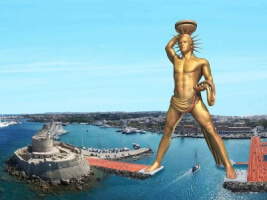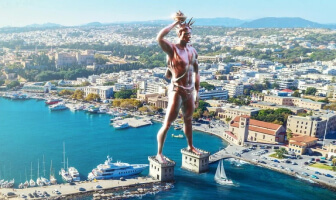Can You Visit the Colossus of Rhodes? History and Facts
Before the wonders of the modern-day world, there existed the Seven Wonders of the Ancient World. And one in particular still has people talking to this day - the Colossus of Rhodes, which dates back to ancient Greece. In this guide, we cover the story behind its construction, what made it so remarkable, and whether you can visit it.
What is the Colossus of Rhodes?

Many monuments in Greece were temples, fortresses, and other constructions that people used to serve specific functions. So, was the Colossus yet another temple? Not at all. This ancient wonder was a bronze statue that had been made to honor the sun god Helios. But unlike other statues, this one was massive! Going by the historical records, it towered at about 32 to 33 meters and was about 18 meters wide. So big was it that many have likened its dimensions to those of the Statue of Liberty!
When Was it Made?
One of the most interesting facts about the Colossus, besides its huge size, is the time that was taken to construct it. Records show that the work started at around 292 BCE and continued until 280 BCE. They took 12 years to bring this statue to life! And once it was up, it stood for a good 54 years until an earthquake shook the very ground that it stood on and brought it crashing down.
What Was the Thinking Behind the Statue?
Building a statue over 30 meters tall and almost 20 meters wide is not something that people do out of a whim. So, what's the real story behind the making of the Colossus?
It all started when Demetrius I of Macedon started attacking the City of Rhodes in 305 BCE. Back then, Demetrius was known for his incredible power and ability to take over other cities. In fact, his name was 'the besieger of Cities.' So, whenever he set his eyes on a new city, he meant business, and the odds were often in his favor.
Demetrius came ready, with an army that was ready to go the extra mile and a ton of ships. He even had a siege tower, which stood at 36 meters. But the Rhodians were not willing to let their city go and were quick to enlist the help of Ptolemy I of Egypt. For the next year, the two sides fought each other with all they had. And finally, Demetrius decided it was time to let go of his plans, reach an agreement with the Rhodians, and be on his way. He even left behind the equipment he had been using to attack the city - the Rhodians had won this round!
As you can imagine, the Rhodians were beside themselves with joy. It was at this time that they decided to give thanks to their god, who was the sun god Helios. But what could they do to show how grateful they were? They decided to take what Demetrius had left behind, sell it, and use the money to make a statue of their god. Since Demetrius had left a lot of equipment behind, the Rhodians were able to generate a good amount of money. They then asked Chares of Lindos to build a statue that would honor their god. And over the next 12 years, that is what he did, finally creating a structure that has had people talking to this day.
Was the Statue Functional?

There are many stories and ideas about how the Rhodians used the statue. But for this guide, we will stick to the facts - that's not to say that the myths are not exciting, though. So, what did people get out of it?
- It was a religious symbol. The main goal behind making the statue was to honor Helios. So, with the statue towering over the city, people were able to show just how thankful they were to him for the help he had given to the city during the war.
- It was a show of power. There is no denying that defeating Demetrius was a significant event for the Rhodians. And in putting up the statue, they were able to advertise this to other people.
Also, given the amount of money that the city had used to make the statue, its existence was a way to show off wealth.
Can You Visit It?
And now we get to the age-old question. Can you visit the statue? Unfortunately, once the earthquake brought it down, it lay on the ground for almost 900 years and wasn't put back together. Even on the ground, it was still a work of wonder. But this was not to last. While the Rhodians had been able to defeat Demetrius, they were unable to keep the Arabs from conquering them. And in 654 AD, the city fell into the hands of the Arabs, who sold what remained of the statue.
Even though the statue does not exist anymore, it's still possible to visit it by touring the island. Here, you can go to the harbor where it once stood and take a walk down memory lane.
